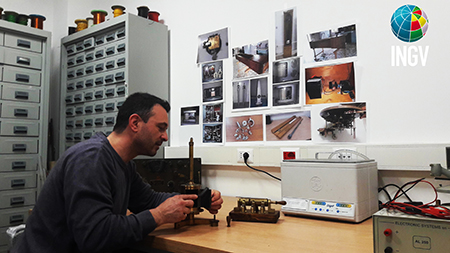
L'Aquila is a historic seat of the National Institute of Geophysics which in 1999 was transformed into the National Institute of Geophysics and Volcanology (INGV). The headquarters, born as a Seismic Observatory, was founded in 1958 on the occasion of the International Geophysical Year, around the Preturo Geomagnetic Observatory, the first in Italy. Subsequently expanded in the XNUMXs with magnetic observations, it boasts an important historical-scientific instrumental heritage. A testimony of the past that could not be overlooked. Manuele Di Persio, technical collaborator of INGV, takes care of the restoration of these precious objects.
When did the process of enhancing the historical heritage of the INGV headquarters in L'Aquila begin?
Over time, dozens of scientific instruments were deposited in the basement of the sixteenth-century castle, then forgotten. Following the reconstruction activities of the city's historical building heritage after the tragic earthquake of 2009, they were rediscovered by the dust and humidity of the time. Facing all the difficulties that presented themselves, but with insistent determination, the desire to give him back a new life took shape. In fact, if on the one hand it was necessary to give an effective response to the legislation on the subject of preservation of scientific assets from degradation and destruction, on the other, there was a strong need for recognition and enhancement of the scientific past of INGV, a history which has contributed to making our institution one of the main research institutions in Italy. The Restoration Laboratory of the L'Aquila office, promoted by Fabrizio Galadini in charge of the INGV office in L'Aquila, is coordinated by my colleague Cesidio Gizzi and myself.
How many instruments have been restored to date?
The restoration of a scientific instrument, like any restoration work, requires a preliminary study and particular attention to the material being acted upon. In these few years of activity it has been possible to restore a dozen instruments, among which a splendid synchronized pendulum from the old seismic station of Aquila certainly stands out (see section "An instrument in 100 words"). Furthermore, a declination meter dating back to the end of the XNUMXth century was found which, most likely, was part of one of the first Italian geophysical observatories born inside the archbishop's palace in L'Aquila. Currently, the Laboratory is engaged in the restoration of a mercury Fortin barometer and a series of meteorological instruments from the XNUMXs. Recently, a school-work alternation collaboration has been launched with two schools in Rome: the Leonardo da Vinci Technical Institute and the Liceo Classico Pilo Albertelli. In both cases, the recovery of various scientific instruments from the end of the XNUMXth century owned by the two institutes was coordinated and followed up. Being able to pass on the technical skills of this activity to young people is the added value of the restoration work, without forgetting the enrichment of knowledge of the evolution of discoveries in scientific research.
Do you organize exhibitions where it is possible to admire these jewels of the past?
Whenever possible, we organize exhibitions of restored historical instruments, especially when the institutional offices request it. It is part of the local culture to know that the path of scientific research in Abruzzo has been intense and rooted in the society of the past. One of the last was organized on 28 September 2018, on the occasion of the researchers' night held in L'Aquila, with an exhibition of geomagnetic instruments at the Palazzo della Regione Abruzzo. And, previously, in 2017 the magnetic and seismic instrumentation was exhibited within the archaeological area of Alba Fucens in Massa d'Albe (AQ).



